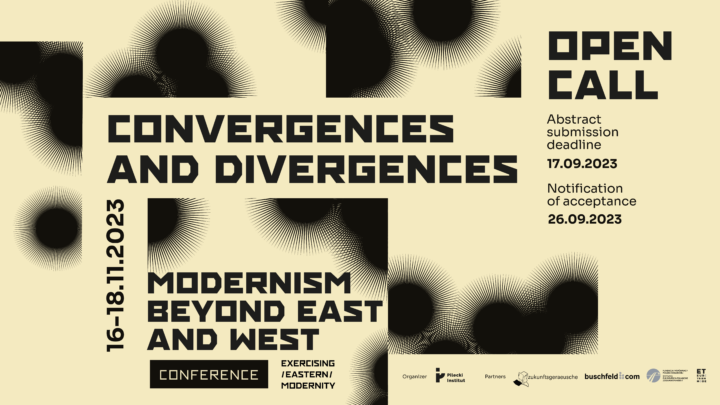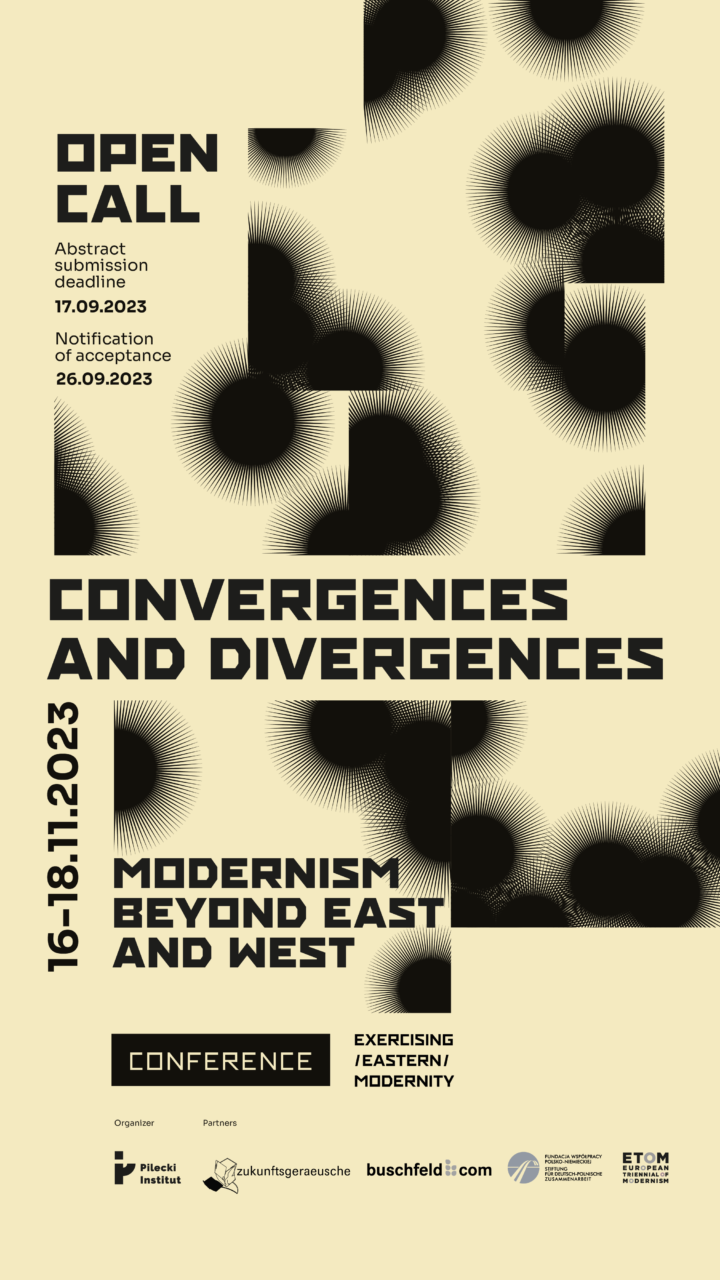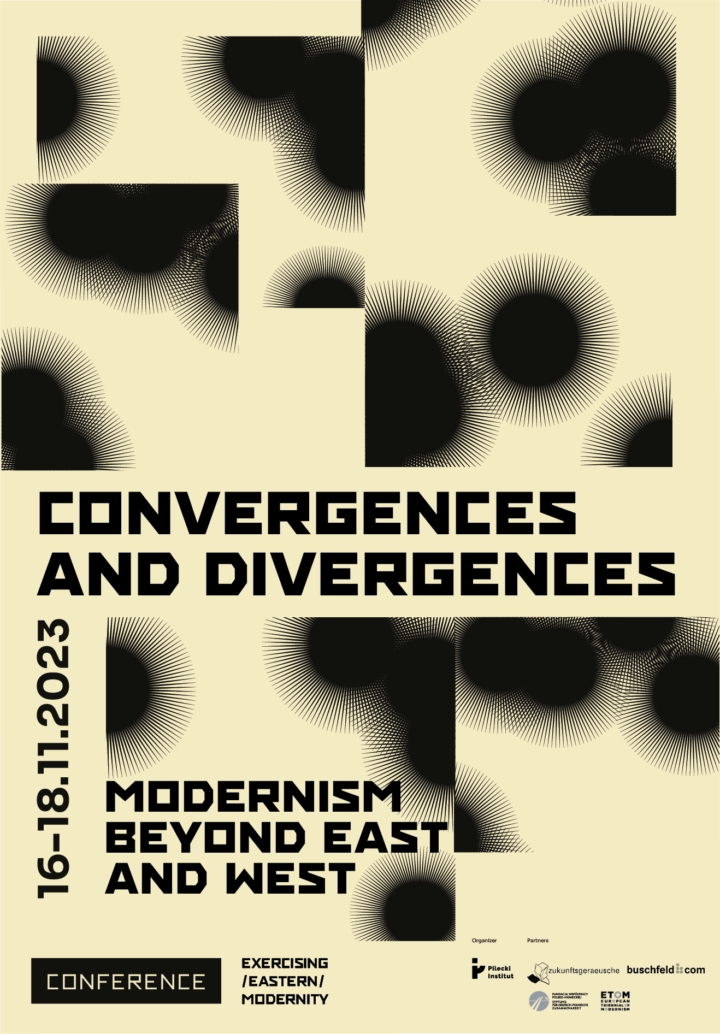CALL FOR PAPERS – Interdisciplinary conference “Convergences and Divergences. Modernism beyond East and West
Interdisciplinary conference: Convergences and Divergences. Modernism beyond East and West
Abstract submission deadline – 17.09.2023
Notification of acceptance – 26.09.202
Conference – 16-18.11.2023
The Organizers of the conference call for contributions that critically rethink and analyze the history of European modern architecture with reference to Central and Eastern Europe
Convergences and Divergences. Modernism beyond East and West
The conference addresses the history of modern architecture from a horizontal and non-hierarchical perspective, overcoming outdated and simplistic categories such as East and West. It will focus not only on design and urban planning issues, but also on questions related to the transformation of societies, the exchange of ideas, the building of relationships between people or the struggle for a better future. The conference approaches architecture from a broader perspective – presenting it as a “seismograph” of the visionary and at the same time ambivalent experience of Modernism, which has much to say not only about the particular moment in history but also about the present.
For too long, theoretical and political constructs have contributed to a territorial or thematic marginalization of Central and Eastern Europe in European architectural historiography. Instead, the conference encourages a closer look at the dynamics between and beyond the political, geographical and cultural borders of Europe in the 20th and 21st century. The aim is not only to analyze the differences, but also to write a history of connections in modern architecture, employing a range of scales and approaches: focusing on timeframes and milestones, exploring cities, regions and borders where histories and memories meet, as well as examining architecture from the perspective of individual stories – those behind biographies or those behind particular architectural objects and ideas of Modernism.
The open call seeks to bring together various perspectives and areas of expertise represented by researchers, architects, designers, architectural historians, urban activists and civic society actors. The main goal is to critically rethink the legacy of Modernism and its associated transformations in Central and Eastern Europe in the context of international relations, dependencies, influence, and power.
The conference builds on the five-year experience of the “Exercising Modernity” program – an interdisciplinary intellectual exchange on art and architecture in a broader sense, exploring how ideas of modernity were reflected in various social and political spheres – and is being organized in cooperation with the initiative for a “European Triennial of Modernism (ETOM)”.
The conference program is shaped along the following five topic areas:
1. CONTESTED ARCHITECTURAL HERITAGE ACROSS CENTRAL AND EASTERN EUROPE
Objects, sites or typologies of compromised or ambivalent history are often referred to as contested, difficult or problematic heritage. All these terms attempt to capture the social resonance of or responsibility for our cultural legacy. This often results in that heritage being excluded from social circulation and appreciation, because from today’s perspective, it is perceived as evidence of a shameful or painful past that has been successfully overcome.
Both rejection of a fragment of the past and the abandonment of care can lead to a gradual decay or even invite active processes of aesthetic devaluation or de facto destruction. The reason may be that such heritage is judged unsuitable by a majority society, a defined group, or the political administration to tell a positive, unifying story about itself or is perceived as “alien”.
The call-section asks for examples of such ambivalent heritage and for contemporary socio-cultural practices in dealing with it – in particular as regards current challenges of post-Soviet traces in modern architecture in Central and Eastern Europe.
2. IRON CURTAIN(S) OF THE 20TH CENTURY. MODERNISM BEYOND THE BINARY OF EAST AND WEST
This section explores the reception and migration of designs and ideas across various divisions that accompanied the Iron Curtain. Rather than focusing on a one-way flow from the center to the periphery, the interest is on a ‘moving map’. Vectors of exchange between West and East are oriented in many ways and directions. The goal is to challenge unidirectional or vertical historical architectural narratives that are often based on the principle of subordination of Central and Eastern European architecture.
The panel aims to trace disconnected histories and obscure biographies. Particular attention will be given to the question, how did ideological and geopolitical rifts and tensions reinforce the demarcation between the notions of Eastern and Western European Modernism? How did they contribute to the suppression or neglect of certain narratives, design principles, and individual stories? How may ideologically motivated exacerbations have hindered or re-channeled the transfer of ideas?
The call asks for examples of biographies or activities that, despite political or ideological barriers, facilitated the flow of ideas and concepts between East and West or West and East – with a particular focus on countries of Central and Eastern Europe and East and West Germany.
3. BUILT NARRATIVES. MULTILAYERED IDENTITIES OF MODERN ARCHITECTURE
Architectural heritage is often used to tell stories about particular versions of the past. In geographical and cultural areas where multiple groups have lived together and various political spheres have intersected, built heritage may consist of numerous historical layers and witness many deliberate aesthetic redesigns. For various reasons, these are not – or have not been made – equally visible.
The call asks for examples of architectural heritage that bear witness to multicultural and multilingual histories, as well as for examples of successful policies and practices. How can plurality be expressed and made accessible through conservation, storytelling, activism, and artistic intervention?
4. SHARED HERITAGE. POINTS OF CONTACT AND BEST PRACTICES
The notion of shared built heritage unveils the hidden networks and the potential for sharing (architectural) history by various communities, nations, regions and countries.
On the other hand, this concept revives sources and risks of tension, as a result of which joint or in-depth exploration is sometimes neglected.
This section is dedicated to strategies for making the public, local communities, authorities and professionals aware of the importance of shared modern history. This includes the same or similar guiding principles, roots, characteristics and design features in modern architecture in Central and Eastern Europe.
The call asks for examples of practices of revitalization, rehabilitation, conservation, documentation, communication and management pertaining to common architectural heritage, with a special focus on the collaboration between various actors involved.
5. NEW COMMUNITIES, NEW BUILDINGS, NEW PEOPLE: THE NOTION OF THE “NEW” IN CENTRAL AND EASTERN EUROPEAN MODERN ARCHITECTURE
Housing is an important part of architectural history, but it also plays a major role in the history of political, social and spatial changes of a particular era. Especially the ideas of social and communal living were labeled “new” at the beginning of the 20th century, when they began to shape cities and social life in various parts of the continent. How did these ideas develop in the first and second half of the 20th century in both East and West?
The panel focuses on centers of change that show diverse developments and layers based on their political history, shifts of borders, migrations and cultures of exile, to examine individual traces, shared models and differences that need to be addressed.
Based on selected case studies, the section discusses examples from polycultural cities such as Berlin, Prague, Kharkiv, Kyiv, Warsaw, Tallinn and Vilnius. Of special interest are significant examples of modern housing settlements for which the initial ideas can be juxtaposed with the present situation and contemporary challenges.
ABSTRACT
Abstracts of 300–500 words plus a short bio (max. 300 words) should be sent to apply@exercisingmodernity.com
DATES AND DEADLINES
Abstract submission deadline: 17 September 2023
Notification of acceptance: 26 September 2023
Conference dates: 16–18 November 2023
VENUE
Pilecki-Institute Berlin,
Pariser-Platz 4a, 10117 Berlin
CONTACT
contact@exercisingmodernity.com
ORGANIZER
Pilecki-Institut Berlin / Exercising Modernity
COOPERATION
ETOM and TDM-Berlin
BHROX bauhaus reuse / zukunftsgeraeusche GbR (BHROX / zkg)
buschfeld.com (bcom)
PARTNER
Stiftung für Deutsch-Polnische Zusammenarbeit
ABOUT EXERCISING MODERNITY
Exercising Modernity is a program of intellectual, artistic and scientific exchange that takes an interdisciplinary approach to describe the heritage of Polish modernity in the context of modernization processes, art and architecture. The aim of the program is to look at the history of Poland – and, more broadly, of Central and Eastern Europe – through the prism of art, architecture and design and to integrate these perspectives into a narrative about twentieth-century Europe. The program particularly seeks to combine historical reflection with questions that help to understand the present: its geopolitical contexts, its difficult – sometimes described as ‘troubled’ –heritage, its relation to the space of everyday life and its special importance in shaping memory and identity, thus offering a different way of looking at history. Exercising Modernity aims to outline a broader and comprehensive perspective on what is understood by Central and Eastern Europe, which will allow for a better understanding of the events, changes and processes that have shaped the divisions between East and West. The program is run by the Pilecki Institute Berlin.
About ETOM – the European Triennial of Modernism
The ETOM initiative develops a co-creation platform on trans-European Modernism and organizes a decentralized triennial festival. ETOM builds on the “Triennale der Moderne” (TDM) festival in Berlin, Dessau, and Weimar, which returned for its fourth edition in 2022.
The initiative was created “bottom-up” during the pandemic in 2021, and has already brought together 38 partners from 14 countries and of a heterogeneous and cross-sectoral background, including 9 official NEB partners. It was launched by the Berlin TDM curators together with partners from across Central Europe, originating from an emerging network based on partners from the 2019 trans-national “re:bauhaus” festival, as well as from DOCOMOMO, ICOMOS and the NEB community.
Following the motto “Diverse Modernism | Modern Diversity”, the ETOM initiative addresses both the heritage of and the future perspectives on Modernism in terms of built heritage and the history of modern ideas, with a particular focus on the sustainability and resilience of such modern values as societal emancipation, social equality, and democratic participation.
ETOM incorporates a circular ecosystem, based on a recurring three-year period, which includes continuous cross-sectoral capacity building and transdisciplinary co-creation culminating with the triennial ETOM festival, which serves not only for public presentation, but also as a target and starting point for the process. In a triangle collaboration between ETOM and the international, widely connected organizations DOCOMOMO and ICOMOS, a strategic initiative “Triangle for Modernism” was launched.
From the very beginning, the ETOM initiative drew special attention to Central and Eastern Europe, its significance and major role in ensuring European unity and cultural resilience, as well as in overcoming a persisting, but outdated East–West divide. The war of aggression against Ukraine clearly shows the importance of Central Europe for European coherence, which should rely, among others, on cultural collaboration and shared modern values.


